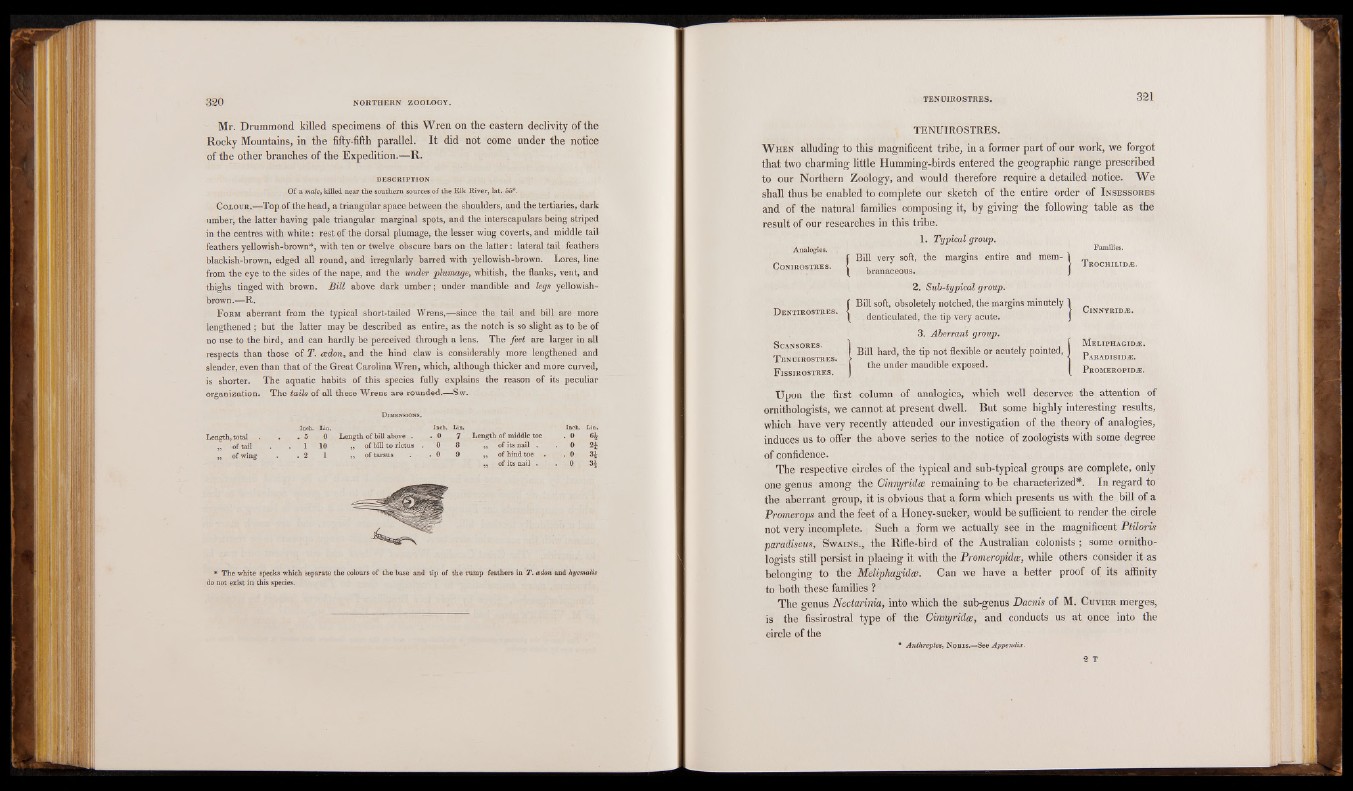
Mr. Drummond killed specimens of this Wren on the eastern declivity of the
Rocky Mountains, in the fifty-fifth parallel. It did not come under the notice
of the other branches of the Expedition.—R.
DESCRIPTION
Of a male, killed near the southern sources of the Elk River, lat. 55°.
C olour.—Top of .the head, a triangular space between the shoulders, and the tertiaries, dark
umber, the latter having pale triangular marginal spots, and the interscapulars being striped
in the centres with white: rest of the dorsal plumage, the lesser wing coverts, and middle tail
feathers yellowish-brown*, with ten or twelve obscure bars on the latter: lateral tail feathers
blackish-brown, edged all round, and irregularly barred with yellowish-brown. Lores, line
from the eye to the sides of the nape, and the under plumage, whitish, the flanks, vent, and
thighs tinged with brown. Bill above dark umber; under mandible and legs yellowish-
brown.—R.
F orm aberrant from the typical short-tailed Wrens,—since the tail and bill are more
lengthened ; but the latter may be described as entire, as the notch is so slight as to be of
no use to the bird, and can hardly be perceived through a lens. The feet are larger in all
respects than those of T. cedon, and the hind claw is considerably more lengthened and
slender, even than that of the Great Carolina Wren, which, although thicker and more curved,
is shorter. The aquatic habits of this species fully explains the reason of its peculiar
organization. The tails of all these Wrens are rounded.—Sw.
Dimensions.
Inch. Lin. Inch. Lin. Inch. Lin.
Length, total . . . 5 0 Length of bill above . . 0 7 Length of middle toe . 0 6£
„ of tail . . 1 10 „ of bill to rictus . 0 8 ,,' of its nail . . 0 2£
,, of wing . . 2 1 „ of tarsus . . 0 9 „ of hind toe . . 0 3£
T , ,, • of its nail . . 0 3§
* The white specks which separate the colours of the base and tip of the rump feathers in T. cedon and hyemalis
do not exist in this species.
TENUIROSTRES.
W hen alluding to this magnificent tribe, in a former part of our work, we forgot
that two charming little Humming-birds entered the geographic range prescribed
to our Northern Zoology, and would therefore require a detailed notice. We
shall thus be enabled to complete our sketch of the entire order of I nsessores and of the natural families composing it, by giving the following table as the
result of our researches in this tribe.
1. Typical group.
Analogies. . ; . . Families. { Bill very soft, the margins entire and mem- 1 _
branaceous. J Tkochili^ '
2. Sub-typical group.
[ Bill s DENTIROSTRES. { , oft, ojb soletel■y' notched, tHhe im argins minutely 1) ClNNYRIDAJ. [ denticulated, the tip very acute.
3. Aberrant group.
S can so r es.
Bill hard, the tip not flexible or acutely pointed,
{M e l iph a g idæ .
T en u iro st re s.
P ara d isidæ .
F iss ir o s t r e s . the under mandible exposed.
P rome ro pidæ.
Upon the first column of analogies, which well deserves the attention of
ornithologists, we cannot at present dwell. But some highly interesting results,
which have very recently attended our investigation of the theory of analogies,
induces us to offer the above series to the notice of zoologists with some degree
of Tcohnef idreenspcee.ctive circles of the typical and sub-typical groups are complete, only
one genus among the Cinnyridw remaining to be characterized*. In regard to
the aberrant group, it is obvious that a form which presents us with the bill of a
Promerops and the feet of a Honey-sucker, would be sufficient to render the circle
not very incomplete. Such a form we actually see in the magnificent Ptiloris
paradiseus, Sw a in s., the Rifle-bird of the Australian colonists; some ornithologists
still persist in placing it with the Promeropidw, while others consider it as
belonging to the Meliphagidce. Can we have a better proof of its affinity
to both these families ?
The genus Nectarinia, into which the sub-genus Dooms of M. C uvier merges,
is the fissirostral type of the Cinnyridw, and conducts us at once into the
circle of the * Anthreptes, Nobis.—See Appendix.